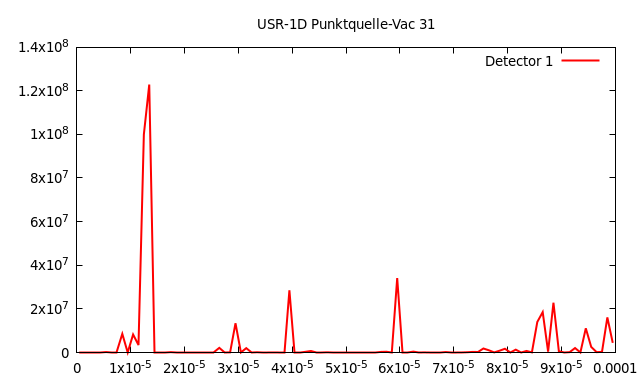Dear FLUKA users,
I was just trying to do a really simple reference simulation to show the compatibility of FLUKA generated data, the formula H*(10)=Γ*A/r² to estimate dose rates and a measurement with a dose rate meter.
Basically what I did is set up a point source and created 3 detectors (1cm³ of water each) in 10cm, 20cm and 40cm distance respectively. I used Co-60, Cs-137, Eu-152 and Am-241 and 2E5 primaries on 10 spawns but only 1 cycle each, but I do not think that is the problem here.
For the first 3 isotopes the results deviate by a maximum of 15% between the 3 versions. But for the Americium FLUKA gives a value that is 15 times above the result of the formula and up to 30 times of the measurement.
From now on I am only looking at Am-241.
My sample has an activity of 1.69E+8 Bq (originally 1.86E8 Bq on 31.12.1967) and I am assuming a distance of 20 cm between detector and probe.
So my three results are
measurement: 13.95 µSv/h
formula: 30.9 µSv/h (I am using 7.30E-03 mSv*m²/GBq/h as dose rate coefficent for Am241)
FLUKA: 411 µSv/h
So FLUKA is way off the other two results. Let me explain how I arrived at the FLUKA result:
My FLUKA-Simulation results in a Dose of 6.755 E-4 pSv per primary. As my detector-regions have a volume of 1 cm³ I only have to multiply this by the number of primaries right?
Instead of using the number of primaries (and that is what I did with all the other isotopes as well) I multiplied by the number of decays happening in one hour. So in my understanding the resulting quantity should be pSv/h or µSv/h in this case:
6.755 E-4 pSv * (1.69E+8 Bq * 3600s/h) = 411 µSv/h
Is this assumption of connecting primaries and activity wrong?
I also changed from that Americium source to a bare 60 keV isotropic photonbeam, but the result was still too high at 58.3 µSv/h.
Can someone enlighten me and point out the error?
Attached you can find my inputfile. There is a potential shield in there, because I wanted to block everything that is not photon.
Punktquelle.flair (3.6 KB)
Punktquelle.inp (2.4 KB)
Also one other Question only related to Am-241: Why does it take so much longer to simulate a primary of Am-241 compared to other isotopes? 0.04ms per Cs-137 vs 1.56ms per Am-241 on my machine.
Edits: spelling and specification.
